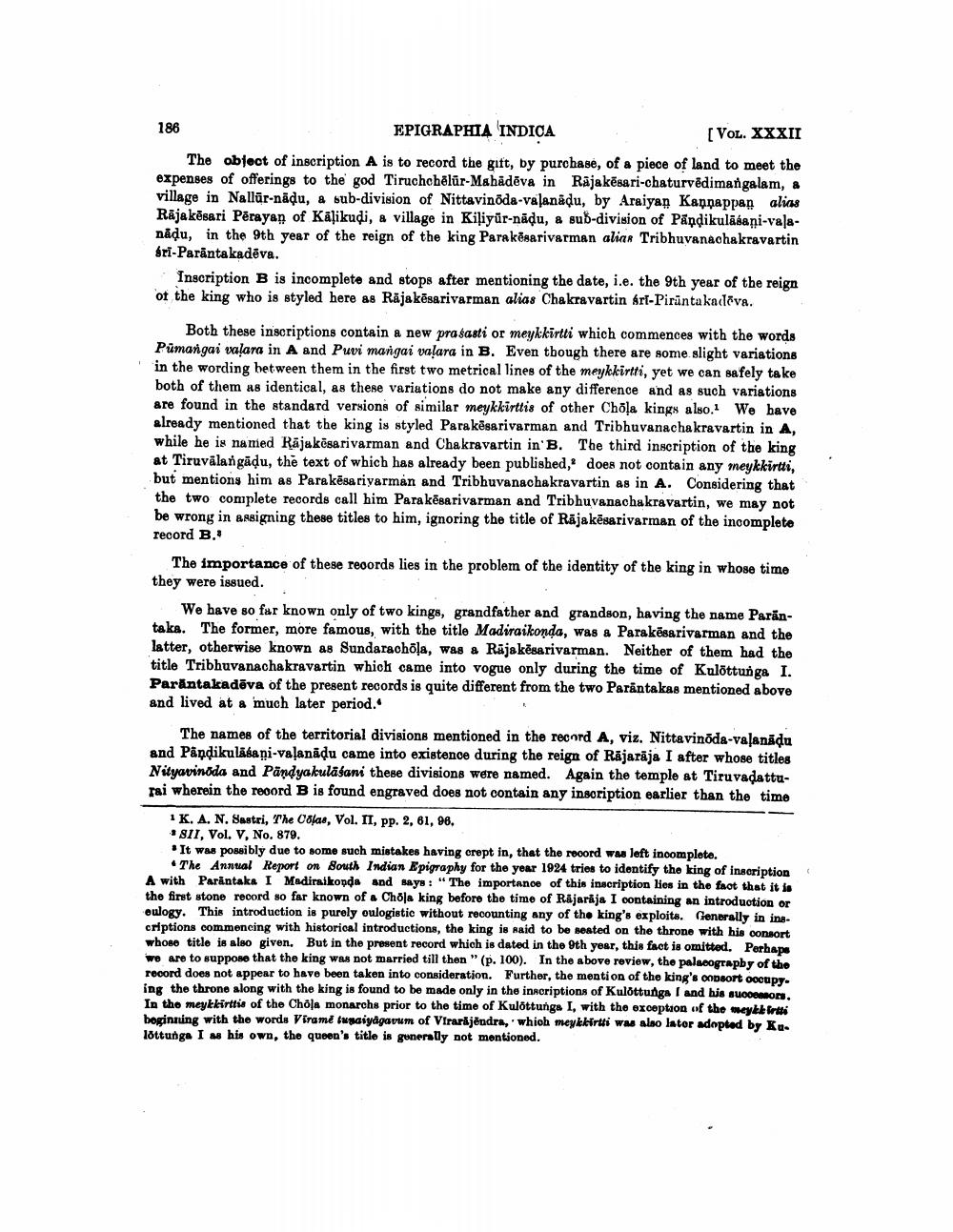________________
186
EPIGRAPHTA INDICA
[VOL. XXXII The object of inscription A is to record the gift, by purchase, of a piece of land to meet the expenses of offerings to the god Tiruchchēlūr-Mahādēva in Rajakēsari-chaturvēdimangalam, & village in Nallur-nadu, a sub-division of Nittavinoda-valanadu, by Araiyan Kannappan alias Rāja kēsari Perayan of Kālikudi, a village in Kiliyūr-nādu, a sub-division of Pandikulāsaņi-valanadu, in the 9th year of the reign of the king Parakësarivarman aliar Tribhuvanachakravartin bri-Parantakadēva.
Inscription B is incomplete and stops after mentioning the date, i.e. the 9th year of the reign of the king who is styled here as Räjakēsarivarman alias Chakravartin Sri-Pirantakadēva.
Both these inscriptions contain a new prasasti or meykkirtti which commences with the words Pümangai valara in A and Puvi mangai valara in B. Even though there are some slight variations in the wording between them in the first two metrical lines of the meykkirtti, yet we can safely take both of them as identical, as these variations do not make any difference and as such variations are found in the standard versions of similar meykkirttis of other Choļa kings also. We have already mentioned that the king is styled Parakesarivarman and Tribhuvanachakravartin in A, while he is named Rājakēsarivarman and Chakravartin in'B. The third inscription of the king at Tiruvālangāļu, the text of which has already been published, does not contain any meykkirtti, but mentions him as Para kēsariyarman and Tribhuvanachakravartin as in A. Considering that the two complete records call him Para kësarivarman and Tribhuvanachakravartin, we may not be wrong in assigning these titles to him, ignoring the title of Rājakēsarivarman of the incompleto record B.:
The importance of these records lies in the problem of the identity of the king in whose time they were issued.
We have so far known only of two kings, grandfather and grandson, having the name Parantaka. The former, more famous, with the title Madiraikonda, was a Parakësarivarman and the latter, otherwise known as Sundarachola, was a Rajakesarivarman. Neither of them had the title Tribhuvanachakravartin which came into vogue only during the time of Kulöttunga I. Parantakadēva of the present records is quite different from the two Parantakas mentioned above and lived at a much later period.
The names of the territorial divisions mentioned in the record A, viz. Nittavinoda-valanādu and Pāņdikuläsapi-valanādu came into existence during the reign of Rājarāja I after whose titles Nityavinoda and Pänd yakuläsani these divisions were named. Again the temple at Tiruvadatturai wherein the record B is found engraved does not contain any inscription earlier than the time
1 K. A. N. Sastri, The Clas, Vol. II, pp. 2, 61, 98. *SI1, Vol. V, No. 879.
It was possibly due to some such mistakes having crept in, that the rooord was left incomplete.
• The Annual Report on South Indian Epigraphy for the year 1924 tries to identify the king of inscription A with Parantaka I Madiraikonda and says: "The importance of this inscription lies in the fact that it is the first stone record so far known of a Chola king before the time of Rajaraja I containing an introduction or oulogy. This introduction is purely oulogistic without recounting any of the king's exploits. Generally in inscriptions commencing with historical introductions, the king is said to be seated on the throne with his consort whose title is also given. But in the present record which is dated in the 9th year, this fact is omitted. Perhaps we are to suppose that the king was not married till then " (p. 100). In the above review, the palacograpby of the record does not appear to have been taken into consideration. Further, the mention of the king's ondeort occupy. ing the throne along with the king is found to be made only in the inscriptions of Kulottunga I and his sumon, In the meykkirttis of the Chola monarchs prior to the time of Kulottunga I, with the exception of the weyblirli borginning with the words Viramd tusaiydgavum of Virarājēndra,' which mekkirti was also lator adopted by Ku. lottunga I as his own, the queen's title is generally not mentioned.




